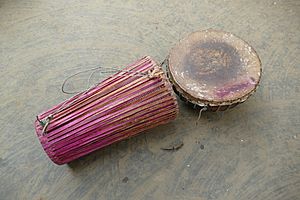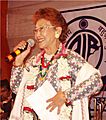Indian music facts for kids

Indian music is super diverse! It has many different styles, just like music in other parts of the world. You'll find pop, classical, and folk music in India. India's classical music is very old, going back hundreds of years. People still love it today for religious reasons or just for fun.
India is home to many different groups of people. Each group has its own language and unique cultural traditions. This makes Indian music very rich and varied.
Contents
What is Tala?
The tala (also spelled tal) is a repeating rhythm pattern. It is usually played on drums like the Tabla. A tala can have anywhere from six to sixteen beats. These beats are grouped into smaller sections.
The very first beat in a tala pattern is called a ‘sam’. This beat is often highlighted. It helps musicians know where a musical section starts and ends.
What is a Raga?
A Raga is also a pattern, but it's different from Western scales or melodies. Think of a Raga as a special mix of scales and melodies. It has its own unique way of going up and down in notes.
Ragas are used to show different things. They can represent the time of day, a season, a certain mood, or a special event.
What is a Drone?
A drone is a note that is either held or repeated throughout a piece of music. It's usually the main starting note of the song.
Today, a drone is often played by an electronic box. But in the past, it was played using an instrument called the tanpura, also known as the Tambura.
What is Improvisation?
Improvisation is when a musician makes up notes as they play. They don't have a fully written piece of music. It's like creating music on the spot!
This way of playing is seen as a form of composing music. It allows musicians to be very creative.
Structures in Indian Music
Indian classical music often follows a specific structure. There are four main parts: Alap, Jhor, Jhala, and Gat/Bandish. Each part has a different role in the music.
Alap
Alap is the first part of a classical music piece from North India. It's a type of melodic improvisation. This means the musician freely explores the Raga. At this point, you usually only hear the singer and the drone.
Jhor
Jhor comes after the Alap. It's a more detailed version of the Raga. This part marks the beginning of the main performance.
Jhala
Jhala is the fast-paced ending of the Raga. In this section, the rhythm often becomes more important than the melody. It's usually very exciting and energetic.
Gat or Bandish
The Gat or Bandish is a fixed musical composition. It is set in a specific Raga. This part is usually played with a Tabla (drums), a drone, and other instruments. These might include a sarangi, violin, or harmonica playing the melody.
Images for kids
-
Nicotine playing at 'Pedal to the Metal' in Indore, India, 2014. They helped start metal music in Central India.
See also
 In Spanish: Música de la India para niños
In Spanish: Música de la India para niños









